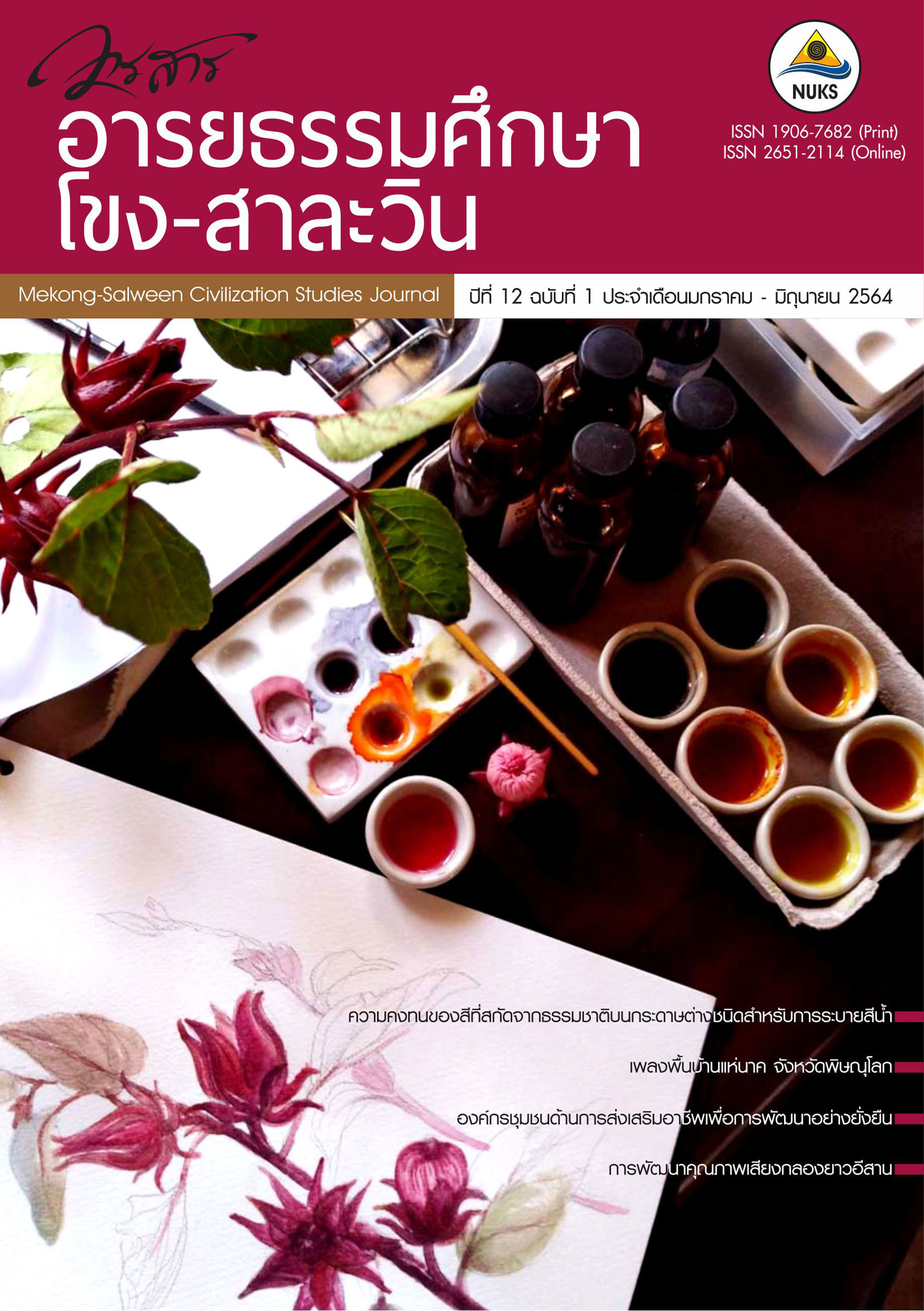The Durability of Natural Extracted Color on the Different Types of Watercolor Paper ความคงทนของสีที่สกัดจากธรรมชาติบนกระดาษต่างชนิดสำหรับการระบายสีน้ำ
Main Article Content
Abstract
This article aims to study the durability of natural extracted color on the different types of watercolor paper by using the natural color extraction, which will be instead of artificial color founded in general. The natural color is less popular at present according to the durability and discoloration. However, the realization of color used safety and the easy finding of local natural substances are initiating and increasingly gaining the use of natural color. In this study, three groups of plants includingyellow from Haem (Coscinium fenestratum (Goetgh.) Colebr), fruit of Cape Jasmine (Gardenia jasminoides J.Ellis) and Curcuma (Curcuma longa L.), red from Smilax china L., Sappan Tree (Caesalpinia sappan L.), and Roselle (Hibiscus sabdariffa L.), blue from Butterfly Pea (Clitoria ternatea L.), and fresh leaves as well as fermented Horm (Strobilanthes cusia (Nees) Kuntze) are selected and extracted by 95% ethanol (C2H5OH) as solvent. Then, plating on 300-gram watercolor paper and 300-gram with cotton 100% watercolor paper. For the measurement of color value, the digital image colorimeter (DIC) is used for comparing L*a*b* value on the 2-type watercolor paper as well as measuring the saturation and examining brightness (discoloration). By the duration of 6 months, it is found that there is no the increase of the brightness value (L*) found in Haem (Coscinium fenestratum (Goetgh.) Colebr) and fruit of Cape Jasmine (Gardenia jasminoides J.Ellis). For the yellow color value (+b) of fruit of Cape Jasmine (Gardenia jasminoides J.Ellis) on 300-gram with cotton 100% watercolor paper, it provides the most drastic decrease at the different level of 5.73 while Curcuma (Curcuma longa L.) is gaining the highest brightness at the different level of 6.40 on watercolor paper with cotton. For the red color value (+a) of Smilax china L. and Sappan Tree (Caesalpinia sappan L.), there is no increase of brightness value found. In contrast, Roselle (Hibiscus sabdariffa L.) provides the highest brightness at the different level of 16.65 on watercolor paper with cotton. Besides, the red color value of Roselle (Hibiscus sabdariffa L.) provides the most drastic decrease of color change at the different level of 20.98 on 300-gram with cotton 100% watercolor paper. For the blue color value, the brightness value (L*) in the fresh leaves of Horm (Strobilanthes cusia (Nees) Kuntze) provides the highest increase at the level of 4.00 on 300-gram with cotton 100% watercolor paper. For the blue color value (-b*), Butterfly Pea (Clitoria ternatea L.) provides the highest change color at the different level of 11.43 on 300-gram with cotton 100% watercolor paper.
Downloads
Article Details
References
Buachoon, N. (2015). Development of Lotion from Albizia myriophylla Benth. Cured Extracts as Antioxidant. VRU Research and Development Journal Science and Technology, 10(2), 97-106.
Chiubang, T. (2004). Learning color theory. Bangkok: Odeon Store.
Indranupakorn, R. (2007). The screening and extraction of active constituents from the herbs. Bangkok: Chulalongkorn University Press.
Kulprasoot, P. (2010). Technical color (6th ed.). Bangkok: Chulalongkorn University Press.
Narongdecha, W. (2019). Natural Color Extraction for Painting. Asia-Pacific Journal of Science and Technology, 24(3), 1-11.
Soonthonchai, B. (1998). Color from plants; non-toxic aesthetic. Green World, 7(3), 54-63.
Suksangsuwarn, R. (2004). Thai Khang Thai Viang Cloth. Bangkok: Bhumpanya.
Tamil Selvi, A., Aravindhan, R., Madhan, B., & Raghava Rao, J. (2013). Studies on the application of natural dye extract from Bixa orellana seeds for dyeing and finishing of leather. Industrial Crops and Products, 43, 84-86.
Thanikkun, T. (2015). Extraction Conditions on Properties of Bioactive Compounds of Lotus Leaves Extract (Nelumbo nucifera Gaertn.). Naresuan University Journal: Science and Technology, 2015(2), 34-42.
Wanichpongpan, P. (2017). Extraction and Quantitative Studies of Essential Compounds in Horny Goat Weed (Epimedium). KMUTT Research and Development Journal, 40(4), 533-542.


